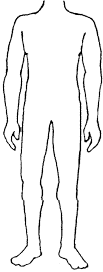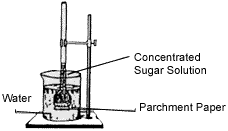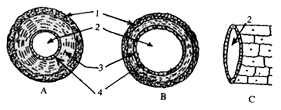ICSE Set Qa1 Year Icse Biology99 Qa1.php Biology Exam Paper for students online
|
||||||||||||||||||||||||||||||||
|
(i) Q 3(b)
Mention one point of difference between the following on the basis of what
is given in brackets . |
||||||||||||||||||||||||||||||||
v) Keeping
in mind the root hair cell and its surrounding , name the part that
corresponds to (1) Concentrated sugar solution (2)Parchment paper and (3)
Water in the beaker Q 4(b) (i) What is
meant by 'reflex action ' ? |
||||||||||||||||||||||||||||||||
|
Ans. 4(b) |
||||||||||||||||||||||||||||||||
|
Q 5 (a) The figures given below are cross sections of blood vessels.
(i) Identify the blood vessels A , B and C.
(ii)
(iii) The walls of arteries are thick and muscular . They have smaller lumen while the walls of veins are thin , having fever muscle fibres . The lumen of the veins is larger . (iv) Oxygenated blood flows through A (v) Pulmonary arteries Q 5 (b) Match Column A
with the most appropriate term in Column B . Rewrite the
correct matching pair.
|
||||||||||||||||||||||||||||||||
|
Ans.5(b) 1. Liquid part of blood
without corpuscles is known as plasma . |
||||||||||||||||||||||||||||||||
|
Q 6 (a) The diagram given below represents a defect of vision of the human eye :
(vi) An inverted and small image of an object will be formed . Q 6(b) A
candidate in order to study the importance of certain factors in
photosynthesis took a potted plant and kept it in the dark for over 24
hours . Then in the early hours of the morning she covered one of
the leaves with black paper in the centre only. She placed the potted
plant in the sunlight for a few hours , and then tested the leaf which was
covered with black paper for starch . |
||||||||||||||||||||||||||||||||
|
Ans. 6(b) (i) That sunlight is
necessary for photosynthesis |
||||||||||||||||||||||||||||||||
Q 7 (a) Give suitable explanations for any three of the following : i) Grapes shrink when immersed in a very strong sugar solution . ii) Breathing through the nose is said to be healthier than breathing through the mouth . iii) A higher rate of transpiration is recorded on a windy day rather than on a calm day . iv) Leguminous crops act as natural fertilizers . Ans.7 (a) (i) Grapes show plasmolysis (ii) Because in nose the filtration of dust particles occur . (iii) Because in moving air , the water vapours are quickly removed from the area surrounding the transpiring leaf . (iv) Because bacteria present in root nodules leguminous crops show Nitrogen fixation Q 7(b) Define
the following terms : |
||||||||||||||||||||||||||||||||
|
Ans.7(b) (i) Hormone :- is the
chemical substance which act as chemical messenger . |










